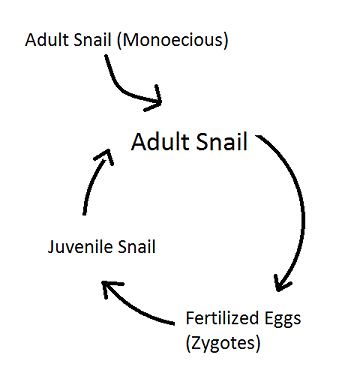Reproduction
According to
Daniel Dourson, Millereilix plicata are
hermaphroditic,
meaning they
 have both ovaries and testes.
Millerelix does NOT
have the famous “love darts” the calcareous appendage that
causes heightened excitement for mating snails. Snails
have a keen ability to find each other in the dark, they have
chemoreceptors on their tentacles which can be used to sense
another snail's slime trail. (Pennsylvania Land Snails
2012) When snails do
decide to reproduce it is a long process of covering their mates
in slime excreted from their foot, then the physical exchange of
sperm to each snail in the form of packets called spermatophores
(Hickman, 2012). The packets enter the snail through the
atrium, a small pore on the right side of a snail's head
(Pennsylvania Land Snails 2012). Usually a few days after the snail has
mated, they will find a dark damp spot to hide their eggs
(Dourson
2010).
have both ovaries and testes.
Millerelix does NOT
have the famous “love darts” the calcareous appendage that
causes heightened excitement for mating snails. Snails
have a keen ability to find each other in the dark, they have
chemoreceptors on their tentacles which can be used to sense
another snail's slime trail. (Pennsylvania Land Snails
2012) When snails do
decide to reproduce it is a long process of covering their mates
in slime excreted from their foot, then the physical exchange of
sperm to each snail in the form of packets called spermatophores
(Hickman, 2012). The packets enter the snail through the
atrium, a small pore on the right side of a snail's head
(Pennsylvania Land Snails 2012). Usually a few days after the snail has
mated, they will find a dark damp spot to hide their eggs
(Dourson
2010).

All terrestrial snails in the phylum Gastropoda have a direct life cycle, meaning they do not go through a metamorphosis, their body form stays consistent throughout their life (Hickman, 2012). The life cycle is as follows, two adult snails mate, creating many zygotes that live in their egg shells. Once hatched they look similar to their parents except for a transparent shell covering much of their anatomy. (Dourson 2010). After a few hours that shell becomes hardened and opaque in color (Dourson 2010). The snail does not reach sexual maturity for at least one year (Dourson 2010).
If you would like to learn more about Snails check out our reference page.